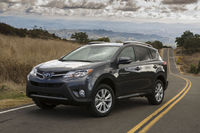Heels on Wheels: 2013 Toyota RAV4 Review
HEELS ON WHEELS
By Katrina Ramser
San Francisco Bureau
The Auto Channel
SEE ALSO: Compare Specs, Prices and Reviews - Toyota Buyers Guide (1997-Present)
INTRO TO THE RAV4 VEHICLE
A grand figure amounting to 80 percent of all Toyota RAVs are still on the road, testament to the reliability of this small-sized SUV. Loyalists and new consumers will undoubtedly be impressed with the RAV4’s refined and contemporary styling, both inside and out, and that the refrigerator-style rear door opening has been exchanged for a liftgate with the rear tire now stored under the cargo floor.
At a recent RAV4 preview event in Arizona, I test drove a 2013 Toyota RAV4 with the standard 176-horsepower 2.5-liter four-cylinder engine and a new 6-speed automatic transmission with Sequential Shift featuring ECO and Sport driving modes. An all-new Dynamic Torque-Control All-Wheel Drive is available with enhances handing and efficiency with a combined fuel economy of 25 miles-per-gallon combined. Streamlined into three trim grades – EX, XLE and Limited – my XLE trim included the following standard features: rearview backup camera; 6.1-inch audio touchscreen display; steering wheel audio controls; Bluetooth; moonroof; French-stitching upholstery accents; dual-zone climate control; fog lights; and roof rails. Add-ons included navigation and Toyota’s popular Entune multi-media system for an extra $1,875. Total vehicle price came to $26,165.
Main competitors – mirroring down the same size, style, value and sporty attributes – are the Mitsubishi Outlander Sport, Kia Sportage and Honda CR-V. However, this segment is vast and wide, so the Nissan Murano, Hyundai Tucson and Ford Escape can also be grouped in this class. (SEE: PERFECT NEW CAR MATCH).
HEELS ON WHEELS REVIEW CRITERIA
Stylish But Comfortable Results: Taking a move right out of the Honda playbook, the rearview camera with display screen is standard even on the base level. The soft-touch dashboard materials, aerodynamic center stack design and color-blocked upholstery options on the RAV4 make many competitor interiors feel ambiguous and uninspiring (if they aren’t there already). The upgrades continue with firmer bolstered seating. Cargo space remains nearly the same at 73.4 cubic feet. My mid-level XLE trim with the standard moonroof, tailored cabin and dual-zone climate control seems like the ideal choice (yet I’d miss the power liftgate that is standard on the Limited). No power seating on any trim. A three-row option no longer exists.
Reliability & Safety Factor: The Insurance Institute for Highway Safety (IIHS) gives the 2013 Toyota RAV4 ratings of “Good” in frontal side impact, and “Acceptable” in roof strength tests. It is not yet rated by The National Highway Traffic Safety Administration (NHTSA). Standard safety equipment includes Toyota’s Star Safety System that includes an advanced airbag system, traction control, enhanced vehicle stability control, anti-lock brakes and Smart Stop Technology.
Cost Issues: The base LE trim starts at $23,300; the XLE trim at $23,300; and the fully loaded Limited tops out at $27,010. A Honda CR-V begins at $22,695 and an entry-level Ford Escape at $22,470.
Activity & Performance Ability: On the paved Arizona landscape, the RAV4 proved to offer spirited handling with a noticeable pulse when in Sport Mode. Gear shifting is smooth and controlled under the new six-speed automatic. Those aerodynamic styling cues, such as the raised hood and more concave-shaped rear, interpret into actual performance and efficiency gains. Steering feel is precise and agile. There is no longer a V6 engine – Toyota reasons buyers would step up to a Highlander if they craved more power.
The Green Concern: The new all-wheel drive system gets 22-city and 29-highway for a combined fuel economy of 25 miles-per-gallon for a 1 mile-per-gallon reduction from old stats. These numbers fall in line with what the CR-V and Outlander Sport offer.
FINAL PARTING WORDS
Lots of significant advantages here with the revised and reliable
2013 Toyota RAV4, all pointing to added value and stellar all-wheel drive
fuel economy – precisely how a small-sized SUV becomes capable of
standing deeply apart from the rest in a highly competitive
segment.
©2013 Katrina Ramser



